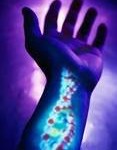Search results
Genetic Genealogy: What is it, how does it work and why should I be interested
October 20, 2011 by ramona
Filed under Articles, General Tips, Getting Started in Genealogy, Introduction to Genealogy

In 1997, a story hit the presses about an English Schoolteacher who was genetically linked to a 9,000-year-old skeleton known as Cheddar Man. Since then genealogy researchers, beginning genealogist and pretty much everyone interested in researching their family tree has become interested in genetic genealogy. However, it was not until 2008 that the genealogical community began to make great strides in using this research method. Today several genealogy groups and genetic researchers offer services that can map your DNA and set you on the path to digging up some very deep roots.
Before considering genetic genealogy as a research method, I think it is important to understand exactly what you can and cannot gain from it. In addition, it might be helpful to put some perspective on where it fits in your genealogical toolbox.
What it will do and what it won’t do
Genetic genealogy does have its limitations; it cannot reveal who your ancestors are. Thus, it is no shortcut to good solid investigation. What it will do is impart evidence about your deepest origins and trace the lines of geographic descent coded in your DNA. When record trails run dry, your genes can reveal the rest of your story. For instance, if your last known ancestor resided in Scotland, a DNA test could point to other global areas and provide some useful clues for continuing research.
Using your DNA as a research tool can also:
- Confirm or eliminate the possibility of descent from a particular family or person
- Connect you to other researchers using DNA for surname studies
- Substantiate or refute findings and conclusions in your family tree research.
This short video by Bennett Greenspan, gives a great short explanation on the subject.
How it works
Should you decide to pursue this method in the search for your roots you will be pleased to know that it has become a relatively simple thing to do. DNA test kits are available from a number of testing facilities and you can order kits by mail or online at a reasonable cost.
The testing kit typically consists of a swab, which is used to collect cells containing your DNA from the inside of your cheek. Once you have employed the swab, the next step is simply to send in your sample. Results are generally available within a few months.
Once the samples arrive at the lab, two types of testing may be used, one for Mitochondrial DNA or mtDNA and one for Y chromosomal DNA.
Mitochondrial DNA
Mitochondrial DNA is found within the cytoplasm of a cell and is passed along the maternal line to both male and female children. Male children however, do not pass it to their offspring. The mtDNA in your cells is a match to your mothers as well as your grandmothers. This type of DNA is better for testing whether or not a genetic relationship exists because it changes at a very slow rate. An mtDNA test will reveal if there is a common maternal ancestor in a genetic line. It will not determine how close that relationship is, so your match could be within a few generations or span hundreds of years.
Y chromosome tests
Y chromosome tests, Y Line or Y DNA tests are tests for men only, as women do not possess a Y chromosome. The Y chromosome passed from father to son, holds chemical markers with a distinctive pattern. This pattern called a Haplotype, clearly differentiates one male genetic line from another; shared patterns in the markers signify relatedness. In spite of this, they cannot distinguish the extent of the relationship. Y chromosome testing is most useful to determine if males with a common last name are the product of a shared ancestor.
Haplogroups
A haplogroup can be determined from markers on both the mtDNA and Y chromosome affording you the information on early ancestry for both the maternal and paternal lines.
Interested in further information? Join the discussion on the forums at “Stumped”.
A Well-Kept Secret: The Internet Archives is an Amazing Resource for Genealogists
October 4, 2011 by ramona
Filed under Articles, General Tips, Getting Started in Genealogy, Introduction to Genealogy
 The Internet Archives is front-page news for all beginning genealogists and family historians. Internet Archives is taking a lesson from the lost library of Alexandria. Alleged to be the greatest repository of knowledge in the known world, the Great Library housed books written by the most renowned scholars and philosophers: but all that was lost when it burned to the ground. In collaboration with the Smithsonian and the Library of Congress, The Internet Archives is actively working to digitize and preserve written records for coming generations. This is great news for genealogists.
The Internet Archives is front-page news for all beginning genealogists and family historians. Internet Archives is taking a lesson from the lost library of Alexandria. Alleged to be the greatest repository of knowledge in the known world, the Great Library housed books written by the most renowned scholars and philosophers: but all that was lost when it burned to the ground. In collaboration with the Smithsonian and the Library of Congress, The Internet Archives is actively working to digitize and preserve written records for coming generations. This is great news for genealogists.
The archives has an ever expanding compilation of resources consisting of items from the National Library of Scotland, The University of Toronto and the Boston Public Library to name a few.
What you will find at the Internet Archives
Some major genealogical resources you can find on their site include Biographical documents, Vital Statistics and books on surname origins. Perhaps most significant to genealogy research is their collection of Old Parish Registers from Great Britain, Canada and the United States. Even better is the fact that accessing this information is easy and free.
How to access records
For beginning genealogists or those new to online research it may seem a little complicated at first. Do not be intimidated, it is actually effortless to get straight to the information you want in three simple steps.
Because Genealogy Beginner is here to help you, we have put together a little walk through to get you started, just click to Old Parish Registers and scroll to the Record of the parish list of deaths. 1785-1819 – Bentley, William, 1759-1819, Salem Mass.
Step one:
Click on Record of the parish list of deaths. 1785-1819 – Bentley, William, 1759-1819, Salem Mass. and it will take you to http://www.archive.org/details/recordofparishli00bent
Step two:
Click on “editable web page” at the bottom of the first text box and it will take you to “Open Library”
Step three:
Click “read online” at the top of the right hand column. Once you are here, you are ready to read. At the bottom of the page, you can use the page-turner icons or simply drag your mouse to select a specific page. The richness of genealogical information is astounding. For instance, on page 143 of this document you can find entry # 1087 that gives the following account:
“Nov.7. Margaret, widow of Benjamin Nurse. Fever, etc., 67 years. She was a Welcome in Daniels Street. Married at 26, and lived thirty years in married life. Her husband a baker. Left two children: eldest son in Boston. Her Brother Thomas married a Lambert. A sister Foye only one left. Daniels Street.”
Wrap up
In addition to the main collection, there are also sub collections that cover passenger lists, Military records and books from the Brigham Young University Family History Library. The Internet Archive is a wholly not-for-profit organization. It was founded for the sole purpose of building an internet library that offers unending access to historical collections for researchers, historians, genealogists and the public. The Internet Archives is a site that all genealogists need to bookmark.
Genealogy or Family History?
October 2, 2011 by ramona
Filed under Articles, Genealogy for Beginners, Getting Started in Genealogy, Introduction to Genealogy
 For many beginning genealogists, the line between the concrete facts of genealogical research and the personal lore of family history are easily blurred. This article by Genealogy Beginner’s resident genealogist, Ramona Hartley clearly demonstrates the difference between the two related but separate fields of study. Do you know the difference between genealogy and family history? When you are a beginning genealogist; taking those first tentative steps in researching your ancestry, it can be difficult to distinguish the difference between them.
For many beginning genealogists, the line between the concrete facts of genealogical research and the personal lore of family history are easily blurred. This article by Genealogy Beginner’s resident genealogist, Ramona Hartley clearly demonstrates the difference between the two related but separate fields of study. Do you know the difference between genealogy and family history? When you are a beginning genealogist; taking those first tentative steps in researching your ancestry, it can be difficult to distinguish the difference between them.
The terms genealogy and family history refer to two separate but equally significant approaches to exploring your roots. The fundamental difference between the two methods lies in the sources of information used to conduct the research. These sources consist of primary, secondary, and tertiary information.
Genealogy
The study of Genealogy refers to the fact based inquiry into your ancestry. It is the concrete process of searching for your genetic origins by gathering and documenting the names, dates and locations of your predecessors. Genealogy requires adherence to the precise information presented within public record to provide irrefutable evidence of your lineage.
A genealogist’s tools are the source materials such as Statutory Index Records for marriages, births, deaths, and baptisms, although at times family bibles and Census Records can be primary sources. To correctly conduct genealogy research you would want to use only primary source information, which means using any record showing a first hand account of an event and containing the signature of a witness.
Family History
Family History refers to the study of the unique details and personal events in your ancestor’s lives; it is their story as told by you, their descendant. Family history research fleshes out the full account that gives life and character to your family tree by including the private details of your generations past; these being the fine points of lives lived that are not found solely within public records. A family historian can use secondary and even tertiary information such as, old photographs, diaries, letters and family lore.
Tying it together
That is not to say that you can not use primary sources for family history research. The study of family history often requires the need to read between the lines of public documents and dig a little deeper to find the tale that lies within. Some truly wonderful opportunities for family history stories are hidden in genealogical data.
Using a fantastic clue found in an Old Parish Record, I will show you how the two can work together.
Genealogy Data + the Family Historian = A Great Story
OPR Extract:
Parish of Carstairs, County of Lanark. Dated May 2nd. 1790
“May 2nd, this day Alexander Gibson in Longflush and Christian Weir had a daughter {Begot in Fornication}. Baptized, Named Janet Gibson.”
The Family History element
This baptismal record from Scotland 1790, tells us that the child being baptized was “begot in fornication”. Even so, both father and mother were listed in the parish record.
Sensing a good family history story, I researched what the term “Begot in Fornication” would have meant to the lives of these individuals in 1700’s Scotland.
What I found was that, the community was very narrow-minded in those days, quick to bring transgressors before the sessions. In this case the father of the child came forward and admitted his liabilities. Due to this he was listed in the record even though he did not marry the mother. The parents of the child being from “good church going families” would have been brought to task publicly and admonished for their sin, this over a period of three Sundays at normal services. Having then been deemed publicly humiliated they would be, so to speak, brought back into the fold and the child baptized.
Wrap up
The short and sweet answer to the question; do you know the difference between genealogy and family history is… You are a genealogist when: you are searching for and documenting records from primary sources and your concern is for factual, proven accounts of births, baptisms, marriages and deaths. You are a family historian when: you are using those facts in addition to reported events that although probable, may not be substantiated by first hand account in the available records; for the purpose of telling the story of your family’s unique and very personal past.
No matter what your method, don’t be surprised if when rediscovering their lives’, you gain a better understanding of your own.
Article Source: http://EzineArticles.com/?expert=Ramona_Hartley
